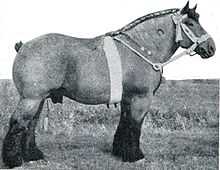Dutch Heavy Draft
 Dutch Heavy Draft | |
| Alternative names | Dutch Draft, Dutch Draught |
|---|---|
| Country of origin | Netherlands |
| Equus ferus caballus | |
The Dutch Heavy Draft Horse, also simply known as the Dutch Draft, Dutch Draught, or Nederland Trekpaard, is a draft horse from the Netherlands. They were developed after World War I for heavy draft and farm work.
History
The Dutch Heavy Draft is a relatively new breed of horse developed in the Netherlands after 1918. They were developed by cross-breeding the Brabant, Zeeland-type Dutch mares and the Belgian Ardennes, and still bear a resemblance to the Brabant.[1] Since 1925 no horse other than those from registered parents are admitted to the stud book.[2]
Characteristics
The Dutch Heavy Draft usually stands around 16 hands high and are generally chestnut, bay or gray, with black seen rarely. The head is well-formed, with a straight profile and pronounced jaw. The neck is powerful, the withers broad and low, the chest deep and the shoulder long and sloping. The back is short and the croup sloping. The legs are strong and muscular, with broad joints.[3] The breed is the heaviest of the Dutch horse breeds. Despite their size, they are very active and economical to keep. They are generally intelligent and tend to have a long working life.[1]
Uses
Traditionally, the Dutch Draft was used for agricultural purposes throughout the Netherlands, especially to plow heavy clay soils which tired many other breeds out. Before mechanisation, they were popular agricultural horses throughout Gelderland, North Brabant and Limburg due to their great strength and willing temperament.[1]
References
| |||||||||||||||||||||||||||||||||||
.jpg)